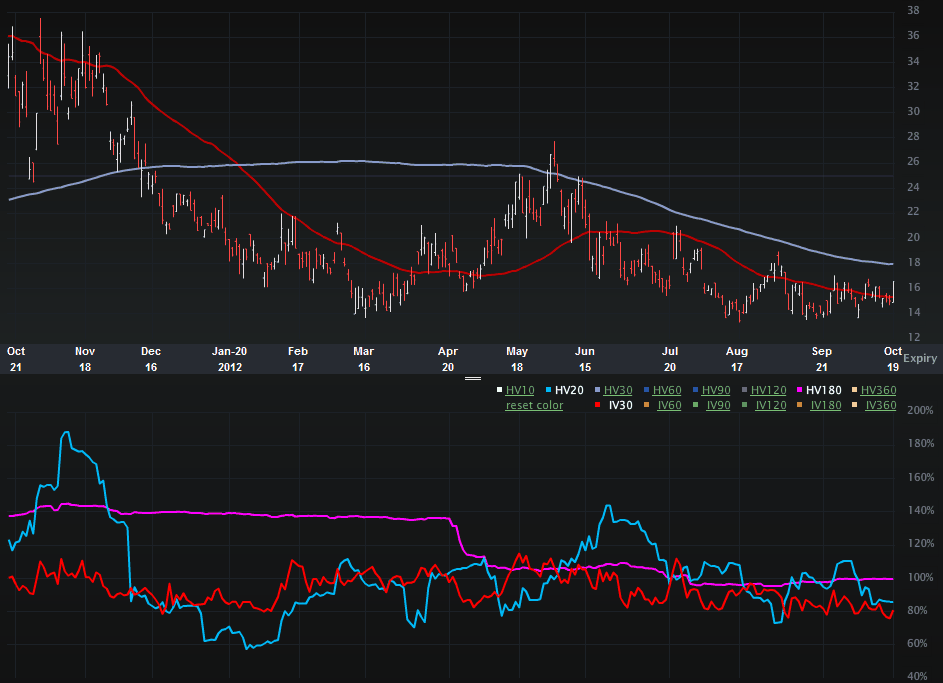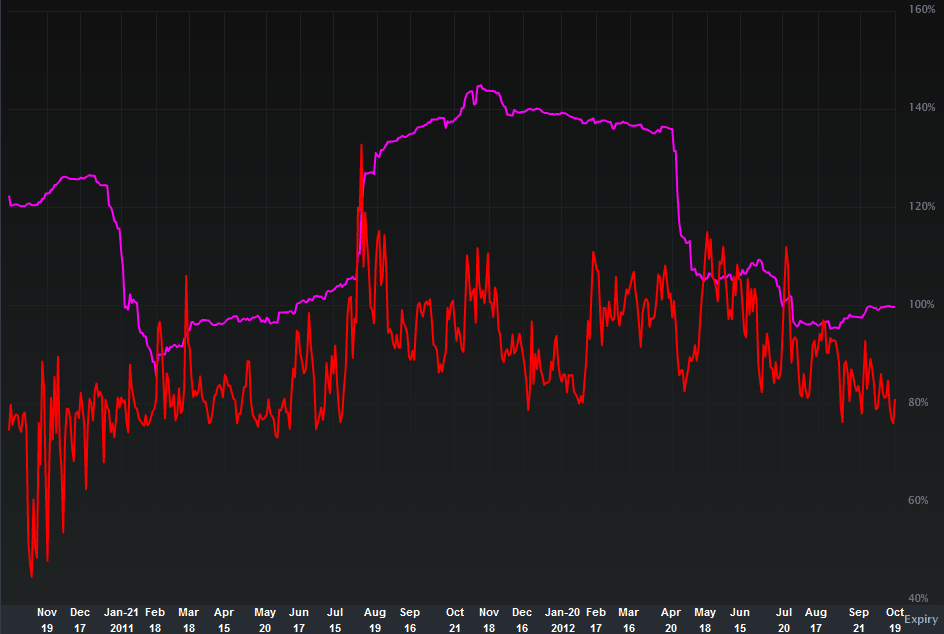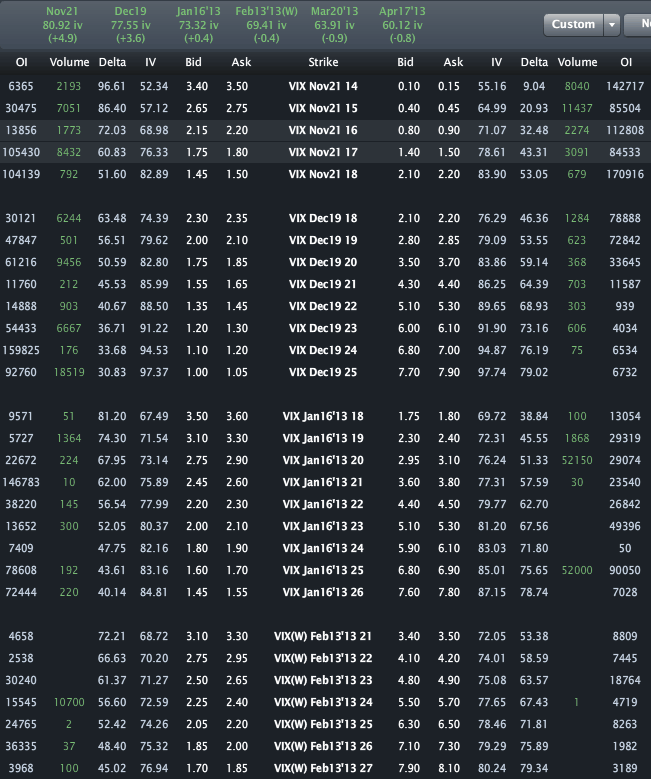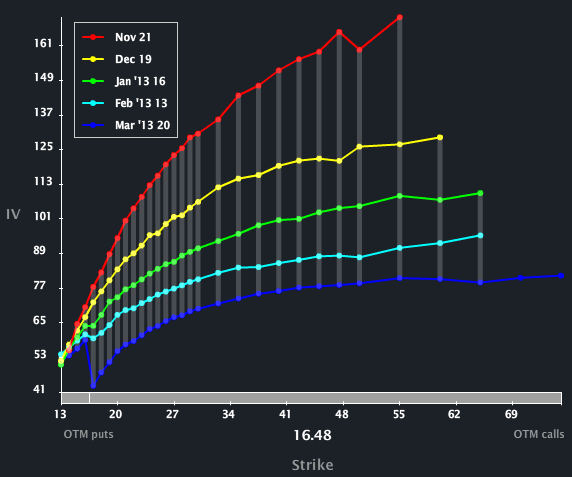VIX is the CBOE volatility index for the SPX – also known as the “Fear Index.” This is a vol and vol of vol note and I will get a bitesoteric when I talk about forward VIX indexes.
Let’s start with the Charts Tab (one-year). The top portion is the stock price the bottom is the vol (IV30™ - red vs HV20™ - blue vs HV180™ - pink).
On the spot side we can see how VIX was substantially elevated last year at this point – well into the mid 30’s. Today we’re looking at a 16.5% VIX after a big move up Friday. If VIX represents the fear index – are we “half as afraid” now as we were a year ago? I dunno, kinda, yeah... Eurozone seems less scary – they’re just gonna use a big ‘ole biscuit of money and wipe up all the debt. That (apparently) is less scary than the Eurozone breaking up.
In fact, if you don’t mind a digression and have wondered what the Eurozone is and why it exists, here’s some stuff I wrote about a few years ago (5-18-2010). So, I’m quoting myself…
You can read the entire article here (5-18-2012): The European Crisis Explained and Currency Option Trading:
The Treaty of Maastricht (formally, the Treaty on European Union) was signed on 7 February 1992 by the members of the European Community in Maastricht, the Netherlands. Amongst other things, it created the rules (requirements) for joining the European Union (i.e. the Euro).
By amalgamating these currencies, countries like Spain, Portugal, Italy and Greece, which were traditionally agricultural economies, are now able to borrow money with the same terms as the highly efficient and industrialized economies (i.e. Germany).
The requirements to enter the EU were focused around debt, inflation and trade. Greece did not meet the requirements, but never fear, Goldman Sachs to the rescue. In a billion Euro swap using the Japanese Yen, Greece was able to "move" (read: hide) debt off the books and allow it to conform to Euro requirements. In fairness to Goldman, Greece and the EU were highly motivated to make this happen, so while Goldman were the actual "arrangers", this thing was gonna happen almost no matter what (that's just my opinion).
Keep in mind that Germany's geo-political clout stems from the EU existing and growing, without it, they're just Germany, with it, they are Europe (is there any precedence to worry about that?... hmmm). The growing risk now is that Spain, Italy, Portugal, Romania, Hungary and a whole bunch more Eastern European countries are on the verge of similar calamities to Greece. FYI, some would consider my use of the word "risk" a vast understatement.
Ok, the quick and dirty lesson over, onto trading and option markets.
To focus a little more easily on the vol of the VIX (the vol of vol), I have included a two year vol chart, with IV30™ in red and HV180™ in pink, below. 
What I note most obviously is that the actual movement of the VIX spot is substantially higher than the implied for most of this two year period. In other words, the risk reflected by the options market of a volatile VIX has been understated relative to the actual spot movement. I also note that tremendous spike in the pink curve from late summer of last year to ~Mar of his year.
All of this is interesting… But, here’s where it gets a little… well, scary…
Let’s turn to the Options Tab.
Note the lower vols by expiry moving from the front to the back (across the top of the tab). Although we could use the futures markets to price forward VIX, I choose to use the options b/c, well, that’s just kind of what I do. Let’s look at what the VIX is priced in the futures markets though the options by backing out the combo, by expiry. I’m going to assume 0% interest rates mostly b/c interest rates are… zero…
I also will use the strike price where the difference between the call prices and put prices are the smallest – that’s the true way to find the ATM options.
Implied future VIX levels through the options market:
Nov (17 strike): 17 + 1.775 – 1.45 = 17.33%
Dec (18 strike): 18 + 2.325 -2.15 = 18.18%
Jan’13 (20 strike): 20 +2.825 – 3.025 = 19.8%
Feb’13 (21 strike): 21 + 3.2 – 3.45 = 20.75%
Mar’13 (22 strike): 22 +3.5 -3.8 =21.7%
Apr’13 (23 strike): 23 + 3.85 – 4.05 = 22.8%
I’ve included these numbers in a line chart, so it’s easier to see the trend:
The point is that the option market (futures market) is implying a steadily increasing VIX for the next six months (ish) -- so more risk in the SPX. So, that’s future pricing... but then there’s this... Let’s look to the Skew Tab.
For those of you that are new to looking at VIX skew, the shape you see is actually normal – keep in mind that a higher VIX is associated with lower SPX values – so this isn’t reverse skew, it’s normal skew. But the compelling part is that each expiry, from front to back, shows lower vol. In English, the option market reflects less risk in the movement of the VIX monotonically for the next half year. At the same time, the futures market looks to a higher value in the VIX in that same time frame (and higher VIX is a reflection of potentially lower SPX values).
This isn’t an impossible situation, in fact, it could be considered semi-normal – but what I read into it given the recent market downturn (i.e. today), is that there is confusion as to the relevant risk levels in the market, and confusion means higher vol in option speak. So what I’m saying? I’m saying that either the vol in the VIX feels low or the value of the VIX feels low too, or both. And neither of those are bullish.
Just as a reminder, the phenomena I am pointing out here are not “crazy unusual,” but taken in the framework of the current environment, they are at the very least worth writing a blog about... And I said, “at the very least….”
Disclosure: This is trade analysis, not a recommendation.
- English (UK)
- English (India)
- English (Canada)
- English (Australia)
- English (South Africa)
- English (Philippines)
- English (Nigeria)
- Deutsch
- Español (España)
- Español (México)
- Français
- Italiano
- Nederlands
- Português (Portugal)
- Polski
- Português (Brasil)
- Русский
- Türkçe
- العربية
- Ελληνικά
- Svenska
- Suomi
- עברית
- 日本語
- 한국어
- 简体中文
- 繁體中文
- Bahasa Indonesia
- Bahasa Melayu
- ไทย
- Tiếng Việt
- हिंदी
Is the VIX Confused? Are We Headed For Collapse -- Or Not Even Close?
Published 10/21/2012, 02:32 AM
Updated 07/09/2023, 06:31 AM
Is the VIX Confused? Are We Headed For Collapse -- Or Not Even Close?
Latest comments
Loading next article…
Install Our App
Risk Disclosure: Trading in financial instruments and/or cryptocurrencies involves high risks including the risk of losing some, or all, of your investment amount, and may not be suitable for all investors. Prices of cryptocurrencies are extremely volatile and may be affected by external factors such as financial, regulatory or political events. Trading on margin increases the financial risks.
Before deciding to trade in financial instrument or cryptocurrencies you should be fully informed of the risks and costs associated with trading the financial markets, carefully consider your investment objectives, level of experience, and risk appetite, and seek professional advice where needed.
Fusion Media would like to remind you that the data contained in this website is not necessarily real-time nor accurate. The data and prices on the website are not necessarily provided by any market or exchange, but may be provided by market makers, and so prices may not be accurate and may differ from the actual price at any given market, meaning prices are indicative and not appropriate for trading purposes. Fusion Media and any provider of the data contained in this website will not accept liability for any loss or damage as a result of your trading, or your reliance on the information contained within this website.
It is prohibited to use, store, reproduce, display, modify, transmit or distribute the data contained in this website without the explicit prior written permission of Fusion Media and/or the data provider. All intellectual property rights are reserved by the providers and/or the exchange providing the data contained in this website.
Fusion Media may be compensated by the advertisers that appear on the website, based on your interaction with the advertisements or advertisers.
Before deciding to trade in financial instrument or cryptocurrencies you should be fully informed of the risks and costs associated with trading the financial markets, carefully consider your investment objectives, level of experience, and risk appetite, and seek professional advice where needed.
Fusion Media would like to remind you that the data contained in this website is not necessarily real-time nor accurate. The data and prices on the website are not necessarily provided by any market or exchange, but may be provided by market makers, and so prices may not be accurate and may differ from the actual price at any given market, meaning prices are indicative and not appropriate for trading purposes. Fusion Media and any provider of the data contained in this website will not accept liability for any loss or damage as a result of your trading, or your reliance on the information contained within this website.
It is prohibited to use, store, reproduce, display, modify, transmit or distribute the data contained in this website without the explicit prior written permission of Fusion Media and/or the data provider. All intellectual property rights are reserved by the providers and/or the exchange providing the data contained in this website.
Fusion Media may be compensated by the advertisers that appear on the website, based on your interaction with the advertisements or advertisers.
© 2007-2025 - Fusion Media Limited. All Rights Reserved.
